Theme D: Precise impact assessments on climate change


| Representative: Eiichi Nakakita Vice Director/Professor, DPRI, Kyoto University |
How will global warming change typhoons, floods, landslides, and river flows as well as the forests and ocean? This research theme, "Precise impact assessment on climate change," aims to scientifically demonstrate the connection between global warming and natural disasters and to look 100 years into the future to see how serious it may become. For these purposes, we use two analytical methods.
One is a method to quantitatively comprehend how climate changes affect river flows and ecosystems, in addition to natural disasters such as typhoon damage and floods, based on probabilities. We are making efforts to further clarify the impact of climate changes on each of these, based on diverse climate change scenarios and using multiple prediction results simulated by diverse climate prediction models. The other method is one that assesses the impact of climate changes on the worst-case scenario which takes extreme external forces such as super typhoons into consideration. In recent years," unprecedented disasters" frequently occur not only in Japan but also in countries across the world. We will provide basic information for appropriate countermeasures that will be needed in the future by analyzing, from scientific and engineering perspectives, how much damage the most destructive, unprecedented disasters resulting from climate changes will cause and by extending our understanding to economic damage specifically and numerically.
In this research theme, we are carrying forward research using the above two analytical methods ("probability assessment of future impact" and "future impact assessment based on the worst-case scenario") and are actively exchanging views under the three research sub-themes:" climate change impacts on natural hazards," "climate change impacts on water resources," and" climate change impacts on ecosystems and biodiversity."
 Climate change impacts on natural hazards
Climate change impacts on natural hazardsThe first sub-theme, climate change impacts on natural hazards, is handled by the Disaster Prevention Research Institute of Kyoto University (DPRI-KU), together with the International Centre for Water Hazard and Risk Management (ICHARM/PWRI). We aim to produce predictions for scenarios covering the worst case particularly for typhoons, which cause the most serious weather-related damage in Japan, concerning the frequency, scale, accompanying precipitation, strong winds, high tides, high waves, and landslides, including during the rainy season.
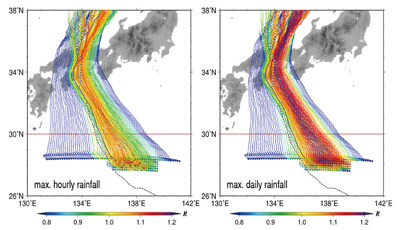
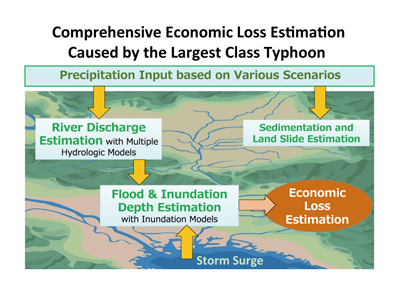
There are approximately 25 typhoons annually and around 10 of those approach or make landfall in Japan. The number of typhoons may not change in the future, but it is known that a small alteration in the path of a typhoon can have an extremely large impact on the amount of rain and wind Japan receives, and as a result, cause immense damage. Specifically, we assess the impact of a complex disaster including precipitation, strong winds, river overflows, and high tide inundation, simulating how different the damage of Isewan Typhoon (T5915) in 1959 would have been if the typhoon had taken a different path, or how powerful or how much damage it would cause if Isewan Typhoon occurs again in the future when the sea surface water temperature has risen due to climate changes (Pseudo global warming experiment; see Fig. 1 to Fig. 5).
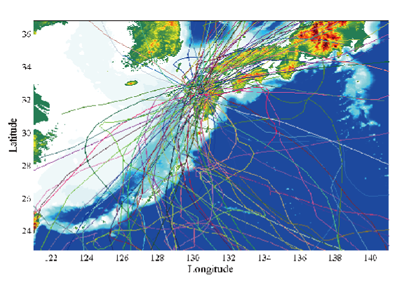
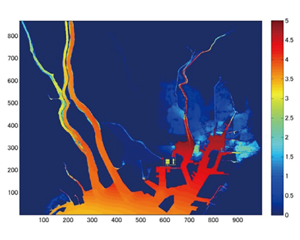
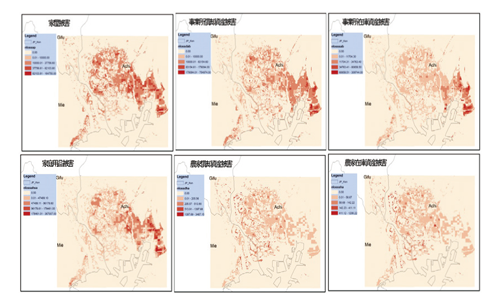
We also predict and assess how the frequency of "100-year return period" disasters and worst-case damage will change in the coming century. Furthermore, we will use this information to understand the impact on society and for national planning. As shown in Fig. 6, the natural disaster impact assessment covers not only Japan but also major rivers in Southeast Asia, with a special focus on floods and inundations.
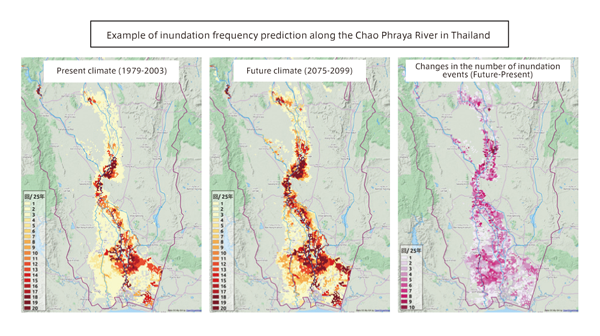
 Climate change impacts on water resources
Climate change impacts on water resourcesThe second sub-theme, climate change impacts on water resources, is handled by DPRI of Kyoto University and IIS of Tokyo University. When the climate changes due to global warming, the rain amount and rain patterns change significantly. It is also possible that what formerly fell as snow will change into rain. In Japan, which has many mountainous regions, it is anticipated that this would cause a great change in the "pattern of water flowing into rivers."

So, the Kyoto University team of this group is predicting and assessing the changes in the flow and supply of water in the main rivers in Japan, the impact on rice farming, etc., and the need for flood control such as dams (see Fig. 7). Similar predictions and assessments are being pursued for the world's major rivers, including in Asia. The University of Tokyo team is predicting and assessing how the actual water cycle will change on a global scale with the addition of artificial modifications. This team is also studying the effectiveness of adaptation strategies (see Fig. 8).

Red: With human activities Blue: Without human activities
 Climate change impacts on ecosystems and biodiversity
Climate change impacts on ecosystems and biodiversityThe third sub-theme, climate change impacts on ecosystems and biodiversity, is supervised primarily by the Graduate School of Life Sciences at Tohoku University, and other participants include Nagoya University, Hokkaido University, and NIES. We aim to predict and assess whether ecosystems are capable of changing abruptly due to global warming, taking as models the forests of northeastern Japan and the marine life in the ocean near Japan (see Fig. 9).
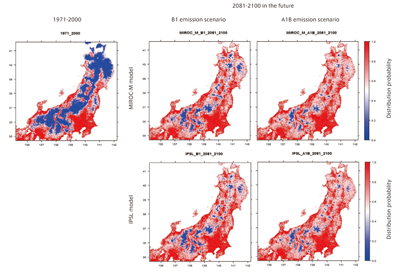
The Tohoku University team is conducting predictions and assessments concerning whether global warming will cause the extinction of alpine plants, the impact of strong wind on forests, the purification effects of forests, changes in tourism resources, etc. The Nagoya University team is conducting predictions and assessments on how climate change alters forest vegetation and then whether the altered forest vegetation affects the climate. The main research sites are Asian rainforests and the eastern boreal in Siberia. The team is studying the changes in the major forests in the world, such as the tundra forest. The team composed of Hokkaido University and NIES focuses on ocean acidification, which occurs when more anthropogenic carbon dioxide dissolves in seawater. The team is predicting and assessing what sorts of changes will occur in coastal marine ecosystems such as coastal reefs and seaweed forests due to global warming and ocean acidification (see Fig. 10).
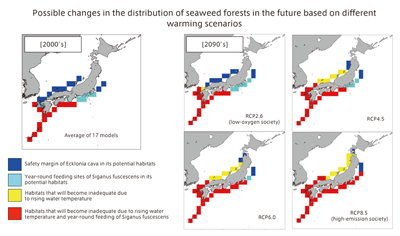
 A bridge to society – The Aim of Theme D
A bridge to society – The Aim of Theme DTheme D aims to" estimate specific numerical figures of climate change impacts" and to" develop a basic approach which serves as a foundation for adaptation." By providing specific numerical figures, the research can contribute to the adaptation methodology with more concrete ideas. The research results are also expected to be considered as basic data for the government and municipalities to consider how to protect the lives of people in urban and rural areas, coastal areas, and river areas. While predicting the future climate is accompanied by high uncertainty, the participating researchers are pushing forward with their research to generate information required to discover appropriate adaption strategies.

